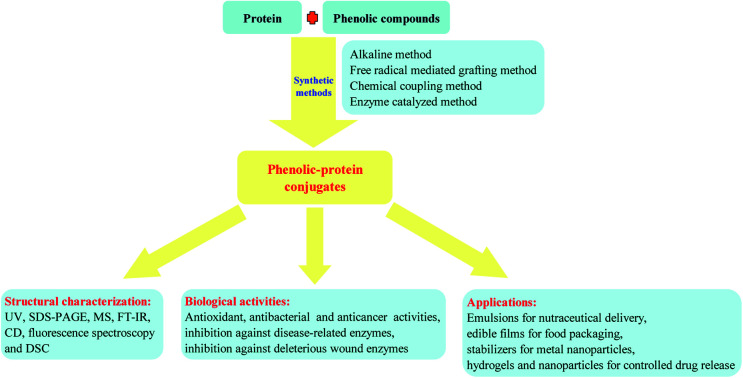- Record: found
- Abstract: found
- Article: found
Recent advances in phenolic–protein conjugates: synthesis, characterization, biological activities and potential applications

Read this article at
Abstract
Proteins and phenolic compounds are two types of food ingredients with distinct functionalities. In the past decade, many attempts have been made to conjugate phenolic compounds with proteins through covalent linkages. Four types of conjugation reactions including alkaline, free radical mediated grafting, enzyme catalyzed grafting and chemical coupling methods are frequently used to synthesize phenolic–protein conjugates. The synthesized phenolic–protein conjugates can be well characterized by several different instrumental methods, such as UV spectroscopy, Fourier transform infrared spectroscopy, fluorescence spectroscopy, circular dichroism, mass spectroscopy, sodium dodecyl sulfate polyacrylamide gel electrophoresis and differential scanning calorimetry. Importantly, phenolic–protein conjugates exhibit improved biological properties ( e.g. antioxidant, anticancer and antimicrobial activities) as compared with native proteins. Moreover, the applications of native proteins can be greatly widened by conjugation with phenolic compounds. Phenolic–protein conjugates have been developed as antioxidant emulsions for nutraceutical delivery, edible films for food packaging, stabilizers for metal nanoparticles, and hydrogels and nanoparticles for controlled drug release. In this review, recent advances in the synthesis, characterization, biological properties and potential applications of phenolic–protein conjugates were summarized.
Abstract
This review summarizes recent advances in the synthesis, characterization, biological activities and potential applications of phenolic–protein conjugates.

Related collections
Most cited references93
- Record: found
- Abstract: found
- Article: not found
Fourier transform infrared spectroscopic analysis of protein secondary structures.
- Record: found
- Abstract: not found
- Article: not found
Phenolic compounds in plants and agri-industrial by-products: Antioxidant activity, occurrence, and potential uses
- Record: found
- Abstract: found
- Article: not found